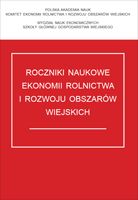Main Article Content
Article Details
Abbott M., Doucouliagos C. 2003: The efficiency of Australia universities: a data envelopment analysis. Economics of Education Review., nr 22, s. 89-97. (Crossref)
Afonso A., Santos M. Students and Teachers: A DEA Approach to the Relative Efficiency of Portuguese Public Universities, http://www.iseg.utl.pt/departamentos/economia/wp/wp072005decisep.pdf (dostęp 30.04.2010).
Afonso A., Santos M. 2004: Public Tertiary Education Expenditure in Portugal: a Non-Parametric Efficiency Analysis, http://www.iseg.utl.pt/departamentos/economia/wp/ wp052004decisep.pdf (dostęp 30.04.2010). (Crossref)
Ahn T., Charnes A., Cooper W. W. 1988: Some Statistical and DEA Evaluations of Relative Efficiencies of Public and Private Institutions of Higher Learning. Socio-Economic Planning Sciences., nr 22, s. 259-269. (Crossref)
Johnes J. 2006: Data envelopment analysis and its application to the measurement of efficiency in higher education. Economics of Education Review., nr 25, s. 273-288. (Crossref)
Johnes J., Johnes G. 1995: Research Funding and Performance in U.K. University Departments of Economics: a Frontier Analysis. Economics of Education Review., Vol. 14, No. 3, s. 301-314. (Crossref)
Johnes J., Yu L. 2008: Measuring the research performance of Chinese higher education institutions using data envelopment analysis. China Economic Review., nr 19, s. 679-696. (Crossref)
Kania W. 1998: Zastosowanie metody DEA do porównywania efektywności kształcenia w szkołach wyższych, [w:] Ekonometria czasu transformacji, (red.) A. Barczak, Katowice, s. 187-196.
Kao C., Hung H.-T. 2008: Efficiency analysis of university departments: An empirical study, Omega 36 .The International Journal of Management Science., s. 653-664. (Crossref)
Ng Y.C., Li S. 2009: Efficiency and productivity growth in Chinese universities during the post-reform period. China Economic Review., nr 20, s. 183-192. (Crossref)
Pasewicz W., Słabońska T., Świtłyk M. 2009: Ocena kształcenia w publicznych uczelniach rolniczych w latach 2001-2005. Zagadnienia Ekonomiki Rolnej., nr 1(318), s. 57-72.
Polskie szkolnictwo wyższe. Stan, uwarunkowania, perspektywy, Wydawnictwa Uniwersytetu Warszawskiego, Warszawa 2009.
Strategia rozwoju szkolnictwa wyższego 2010-2020. Projekt środowiskowy. Wydawnictwa Uniwersytetu Warszawskiego, Warszawa 2009.
Szkolnictwo wyższe 2006. Dane podstawowe. Informator, MNiSW, Warszawa 2007.
Szkolnictwo wyższe 2007. Dane podstawowe. Informator, MNiSW, Warszawa 2008.
Szkolnictwo wyższe 2008. Dane podstawowe. Informator, MNiSW, Warszawa 2009.
Szuwarzyński A. 2006a: Metoda DEA pomiaru efektywności działalności szkół wyższych, Nauka i Szkolnictwo Wyższe., nr 2/28, s. 78-88.
Szuwarzyński A. 2006b: Rola pomiaru efektywności szkoły wyższej w kształtowaniu jej pozycji konkurencyjnej, [w:] Konkurencja na rynku usług edukacji wyższej, Fundacja Edukacyjna Przedsiębiorczości, Łódź, s. 213-224.
Założenia do nowelizacji ustawy - Prawo o szkolnictwie wyższym oraz ustawy o stopniach naukowych i tytule naukowym oraz o stopniach i tytule w zakresie sztuki, http://www.bip.nauka.gov.pl/_gAllery/73/10/7310/20091030_EEE_zalozenia_po_RM.pdf (dostêp 10.04.2010).
Downloads
- Jan Pawlak, Economic conditions and farm mechanization , Annals of Agricultural Economics and Rural Development: Vol. 97 No. 3 (2010)
You may also start an advanced similarity search for this article.
- Robert Rusielik, Michał Świtłyk, Changes of technical efficiency of agriculture in Poland in the years 1998-2006 , Annals of Agricultural Economics and Rural Development: Vol. 96 No. 3 (2009)
- Michał Świtłyk, Mirosław Helta, Efficiency of milk production in farms belong to European Dairy Farmers (EDF) in 2006 , Annals of Agricultural Economics and Rural Development: Vol. 96 No. 1 (2009)
- Robert Rusielik, Michał Świtłyk, TECHNICAL EFFICIENCY OF MILK PRODUCTION IN THE SELECTED EUROPEAN FARMS IN YEARS 2008-2010 , Annals of Agricultural Economics and Rural Development: Vol. 99 No. 1 (2012)
- Michał Świtłyk, Mirosław Helta, Technical efficiency of the milk production in EDF farms in a year 2004 , Annals of Agricultural Economics and Rural Development: Vol. 93 No. 1 (2006)
- Michał Świtłyk, Mirosław Helta, Efficiency of milk production in farms belonging to European Dairy Farmers (EDF) in 2005 , Annals of Agricultural Economics and Rural Development: Vol. 93 No. 2 (2007)
- Michał Świtłyk, Mirosław Helta, Technical efficiency of agricultural farms belonging to Agricultural Property Agency (APA) in 1994-2006 , Annals of Agricultural Economics and Rural Development: Vol. 95 No. 1 (2008)
- Michał Świtłyk, Mirosław Helta, Technical efficiency of studs belong to agricultural property agency (APA) in 1994-2006 , Annals of Agricultural Economics and Rural Development: Vol. 96 No. 3 (2009)




